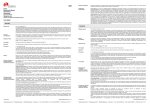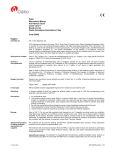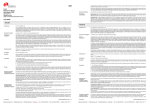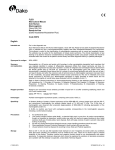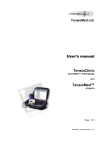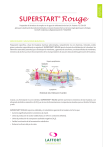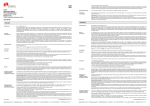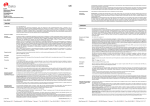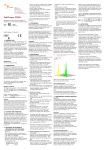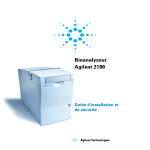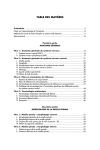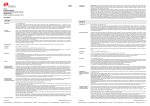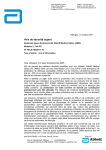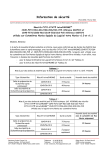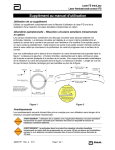Download FLEX Monoclonal Mouse Anti-Human Podoplanin Clone D2
Transcript
FLEX Monoclonal Mouse Anti-Human Podoplanin Clone D2-40 Ready-to-Use (Dako Autostainer/Autostainer Plus) English Code IS072 Intended use For in vitro diagnostic use. FLEX Monoclonal Mouse Anti-Human D2-40, Clone D2-40, Ready-to-Use (Dako Autostainer/Autostainer Plus), is intended for use in immunohistochemistry together with Dako Autostainer/Autostainer Plus instruments. This antibody labels the lymphatic endothelium marker podoplanin in normal and neoplastic tissues. The antibody may be useful in the identification of lymphatic invasion of a variety of cancers (1, 2). The clinical interpretation of any staining or its absence should be complemented by morphological studies using proper controls and should be evaluated within the context of the patient's clinical history and other diagnostic tests by a qualified pathologist. Summary and explanation Podoplanin is a ~38 kDa O-linked transmembrane sialoglycoprotein which is expressed in the endothelium of lymphatic capillaries, but not in the blood vasculature (5). Besides the expression in lymphatic endothelium, podoplanin is also found in a variety of other tissues, including mesothelial cells, reticular cells, follicular dendritic cells, ovarian and testicular germ cells (6). Anti-Podoplanin has also been demonstrated to react with lymphatic endothelium and is unreactive with vascular endothelium (1, 2). In neoplastic tissue, immunostaining of lymphatic endothelium by Anti-Podoplanin has been shown to be useful in identifying lymphatic invasion of primary tumors (1, 2). The use of calretinin and podoplanin markers in conjuction has been shown to improve differentiation of mesothelioma versus metastatic adenocarcinoma (6). Podoplanin has also been shown to be a useful marker for the differential identification of seminomas and follicular dedritic cell tumors (4). Refer to Dako’s General Instructions for Immunohistochemical Staining or the detection system instructions of IHC procedures for: 1) Principle of Procedure, 2) Materials Required, Not Supplied, 3) Storage, 4) Specimen Preparation, 5) Staining Procedure, 6) Quality Control, 7) Troubleshooting, 8) Interpretation of Staining, 9) General Limitations. Reagent provided Ready-to-use monoclonal mouse antibody provided in liquid form in a buffer containing stabilizing protein and 0.015 mol/L sodium azide. Clone: D2-40 (1). Isotype: IgG1, kappa. Immunogen Dysgerminoma tissue (1). Specificity Anti-Podoplanin, Clone D2-40 was tested by Western blotting of cell lysates from a variety of tumor cell lines. The antibody identified a ~40 kDa band in immunoblots of HEY ovarian epithelial carcinoma cells and a slightly higher molecular weight form in blots of MGH-U3 cells. Immunoreactivity has also been observed in Western blots of SK-OV-3 and Caov-3 ovarian epithelial carcinoma cells, PA-1PA-1 ovarian teratocarcinoma cells, Tera-1 and Tera-2 testicular teratocarcinoma cells, 833 embryonal carcinoma cells, RT-4 bladder transitional carcinoma cells and U-2 OS osteosarcoma cells. No reactivity was observed in Western blots of other tumor cell lines derived from a variety of cancers (1). The effect of enzyme digestion on the immunoreactivity of clone D2-40 was tested using affinity purified antigen from HEY cells and intact HEY cells. The immunoreactivity in Western blots of purified antigen and with cells by flow cytometry was unaffected by the removal of sialic acid residues through neuraminidase treatment of the cells or protein. Treatment of protein or cells with O-sialoglycoprotease destroyed the immunoreactivity of clone D2-40 in both Western blotting and flow cytometry, demonstrating that the antigen recognized is an O-linked glycoprotein (1). Precautions 1. 2. 3. 4. 5. Storage (118932-002) For professional users. This product contains sodium azide (NaN3), a chemical highly toxic in pure form. At product concentrations, though not classified as hazardous, sodium azide may react with lead and copper plumbing to form highly explosive build-ups of metal azides. Upon disposal, flush with large volumes of water to prevent metal azide build-up in plumbing. As with any product derived from biological sources, proper handling procedures should be used. Wear appropriate Personal Protective Equipment to avoid contact with eyes and skin. Unused solution should be disposed of according to local, State and Federal regulations. Store at 2-8 °C. Do not use after expiration date s tamped on vial. If reagents are stored under any conditions other than those specified, the conditions must be verified by the user. There are no obvious signs to indicate instability of this product. Therefore, positive and negative controls should be run simultaneously with patient specimens. If unexpected staining is observed which cannot be explained by variations in laboratory procedures 307712EFG_002 p. 1/4 and a problem with the antibody is suspected, contact Dako Technical Support. Specimen preparation including materials required but not supplied The antibody can be used for labeling formalin-fixed, paraffin-embedded tissue sections. Tissue specimens should be cut into sections of approximately 4 µm. Pre-treatment with heat-induced epitope retrieval (HIER) is required. Optimal results are obtained by pretreating tissues using EnVision FLEX Target Retrieval Solution, High pH (50x), (Dako Autostainer/Autostainer Plus) (Code K8010/K8014). Deparaffinized sections: Pre-treatment of deparaffinized formalin-fixed, paraffin-embedded tissue sections is recommended using Dako PT Link (Code PT100/PT101). For details, please refer to the PT Link User Guide. Follow the pre-treatment procedure outlined in the package insert for EnVision FLEX Target Retrieval Solution, High pH (50x), (Dako Autostainer/Autostainer Plus) (Code K8010/K8014). The following parameters should be used for PT Link: Pre-heat temperature: 65 °C; epit ope retrieval temperature and time: 97 °C for 20 (± 1) minutes; cool down to 65 °C. Remove Autostainer slide rack w ith slides from the PT Link tank and immediately dip slides into a jar/tank (e.g., PT Link Rinse Station, Code PT109) containing diluted room temperature EnVision FLEX Wash Buffer (20x), (Dako Autostainer/Autostainer Plus) (Code K8010). Leave slides in Wash Buffer for 1-5 minutes. Paraffin-embedded sections: As alternative specimen preparation, both deparaffinization and epitope retrieval can be performed in the PT Link using a modified procedure. See the PT Link User Guide for instructions. After the staining procedure has been completed, the sections must be dehydrated, cleared and mounted using permanent mounting medium. The tissue sections should not dry out during the treatment or during the following immunohistochemical staining procedure. For greater adherence of tissue sections to glass slides, the use of Dako Silanized Slides (Code S3003) is recommended. Staining procedure including materials required but not supplied The recommended visualization system is EnVision FLEX, High pH, (Dako Autostainer/Autostainer Plus) (Code K8010). The staining steps and incubation times are pre-programmed into the software of Dako Autostainer/Autostainer Plus instruments, using the following protocols: Template protocol: FLEXRTU2 (200 µL dispense volume) or FLEXRTU3 (300 µL dispense volume) Autoprogram: D240 (without counterstaining) or D240H (with counterstaining) The Auxiliary step should be set to “rinse buffer” in staining runs with ≤10 slides. For staining runs with >10 slides the Auxiliary step should be set to “none”. This ascertains comparable wash times. All incubation steps should be performed at room temperature. For details, please refer to the Operator’s Manual for the dedicated instrument. If the protocols are not available on the used Dako Autostainer instrument, please contact Dako Technical Services. Optimal conditions may vary depending on specimen and preparation methods, and should be determined by each individual laboratory. If the evaluating pathologist should desire a different staining intensity, a Dako Application Specialist/Technical Service Specialist can be contacted for information on re-programming of the protocol. Verify that the performance of the adjusted protocol is still valid by evaluating that the staining pattern is identical to the staining pattern described in “Performance characteristics”. Counterstaining in hematoxylin is recommended using EnVision FLEX Hematoxylin, (Dako Autostainer/Autostainer Plus) (Code K8018). Non-aqueous, permanent mounting medium is recommended. Positive and negative controls should be run simultaneously using the same protocol as the patient specimens. The positive control tissue should include appendix and tonsil and the cells/structures should display reaction patterns as described for this tissue in “Performance characteristics” in all positive specimens. The recommended negative control reagent is FLEX Negative Control, Mouse, (Dako Autostainer/Autostainer Plus) (Code IS750). Staining interpretation The cellular staining pattern is cytoplasmic and membranous. Performance characteristics Normal tissues: The antibody strongly labels lymphatic endothelium, ganglion cells and nerve in many normal tissue types. Vascular endothelial cells are negative in all normal tissues tested (8). Tissue Type (# tested) Positively Staining Tissue Elements Adrenal (3) 2/3 cytoplasm of capsular fibroblasts; 1/3 cytoplasm of interstitial fibroblasts; 1/3 cytoplasm of pericapsular lymphocytes 9/11 cytoplasm of endothelial cells Appendix (11) (118932-002) Bone marrow (3) 0/3 Brain, cerebellum (3) 3/3 cytoplasm of neuropil Brain, cerebrum (3) 3/3 nuclei of rare astrocytes Breast (3) 3/3 cytoplasm of myoepithelial cells Cervix (3) 3/3 membrane and/or cytoplasm of basilar epithelial cells; 3/3 cytoplasm of stromal fibroblasts Colon (3) 2/3 lymphocytes Esophagus (3) 1/3 cytoplasm of ganglion cells in muscle; 1/3 cytoplasm of basilar epithelium 307712EFG_002 p. 2/4 Heart (3) 2/3 cytoplasm of myocytes Kidney (3) 1/3 cytoplasm of pericapsular fibroblasts Liver (3) 0/3 Lung (3) 2/3 cytoplasm of bronchial epithelial cells; 3/3 cytoplasmic edge of alveolar cells Mesothelial cells (3) 1/3 cytoplasm of mesothelial cells Ovary (3) 3/3 cytoplasm of ovarian stromal cells; 1/3 cytoplasm of surface epithelium of inclusion cysts Pancreas (3) 2/3 cytoplasm of periductal fibroblasts; 1/3 cytoplasm of ductal myoepithelial cells Parathyroid (3) 0/3 Peripheral nerve (3) 2/3 cytoplasm of perineurium Pituitary (3) 1/3 cytoplasm of pericapsular fibroblasts in neurohypophysis; 1/3 cytoplasm of neuropil in neurohypophysis Prostate (3) 3/3 cytoplasm of basal cells of ducts; 3/3 cytoplasm of stromal fibroblasts Salivary gland (3) 3/3 cytoplasm of ductal and acinar myoepithelial cells Skeletal muscle (3) 3/3 cytoplasm of perimysium Skin (3) 3/3 cytoplasm of myoepithelial cells of adnexal structures Small intestine (3) 3/3 cytoplasm of myenteric plexus Spleen (3) 0/3 Stomach (3) 3/3 cytoplasm of periglandular fibroblasts; 1/3 cytoplasm of myenteric plexus; 1/3 cytoplasm and membrane of germinal center lymphocytes Testes (3/3) 3/3 cytoplasm of peritubular fibroblasts Thymus (3) 3/3 cytoplasm and membrane of medullary lymphocytes Thyroid (3) 0/3 Tonsil (3) 3/3 cytoplasm and membrane of basilar epithelial cells and germinal center lymphocytes Uterus (3) 3/3 cytoplasm of myometrium; 1/3 cytoplasm of endometrial glands Abnormal tissues (2,7): Tissue Type (# tested) Kaposi’s Sarcoma (24): Patch, plaque and nodular stages Positively Staining Tissue 24/24 Lymphangioma (10) 10/10 endothelium lining the sinusoidal spaces Angiosarcoma (7) 3/7 Leiomyosarcoma (10) 3/10 Dermatofibroma (6) 2/6 Malignant fibrous histiocytoma (2) 1/2 Hemangioma (10) 0/10 Glomus tumor (3) 0/3 Angiolipoma (2) 0/2 Pyogenic granuloma (2) 0/2 Vascular malformation (2) 0/2 Hemangiopericytoma (1) 0/1 Hemangioendothelioma (1) 0/1 Dermatofibrosarcoma protuberans (4) 0/4 Neurofibromas (6) 0/6 Pure Germ cell tumors Seminomas (35) 34/35 Embryonal carcinomas (5) 1/5 Immature and mature teratoma (1) 0/1 Mixed germ cell tumors (118932-002) Seminomas (12) 12/12 Embryonal carcinomas (21) 17/21 307712EFG_002 p. 3/4 Immature and mature teratoma (16) 5/16 Yolk sac tumor (4) 1/4 Choriocarcinoma (2) 0/2 Français Réf. IS072 Utilisation prévue Pour utilisation diagnostique in vitro. L’anticorps FLEX Monoclonal Mouse Anti-Human Podoplanin, Clone D2-40, Ready-to-Use (Dako Autostainer/Autostainer Plus), est destiné à être utilisé en immunohistochimie avec les appareils Dako Autostainer/Autostainer Plus. Cet anticorps marque la podoplanine, marqueur de l’endothélium lymphatique, dans les tissus sains et néoplasiques. L’anticorps peut être utile dans le cadre de l’identification d’une invasion lymphatique de divers cancers (1, 2). L’interprétation clinique de toute coloration ou son absence doit être complétée par des études morphologiques en utilisant des contrôles appropriés et doit être évaluée en fonction des antécédents cliniques du patient et d’autres tests diagnostiques par un pathologiste qualifié. Résumé et explication La podoplanine est une O-sialoglycoprotéine transmembranaire d’environ ~38 kDa exprimée dans l’endothélium des capillaires lymphatiques, mais pas dans le système vasculaire sanguin (5). Outre l’expression dans l’endothélium lymphatique, la podoplanine est également présente dans plusieurs autres tissus, notamment les cellules mésothéliales, les cellules réticulaires, les cellules dendritiques folliculaires, les cellules germinales ovariennes et les cellules germinales testiculaires (6). Il a également été démontré que l’anticorps AntiPodoplanin réagit avec l’endothélium lymphatique et n’est pas réactif avec l’endothélium vasculaire (1, 2). Dans le tissu néoplasique, il a été démontré que la coloration immunologique de l’endothélium lymphatique par l’anticorps Anti-Podoplanin est utile dans le cadre de l’identification d’une invasion lymphatique des tumeurs primitives (1, 2). L’utilisation conjointe des marqueurs calrétinine et podoplanine s’est révélée améliorer la différenciation entre le mésothéliome et l’adénocarcinome métastatique (6). Il a également été montré que la podoplanine est un marqueur utile dans le cadre de l’identification différentielle entre les séminomes et les tumeurs des cellules dendritiques folliculaires (4). Se reporter aux « Instructions générales de coloration immunohistochimique » de Dako ou aux instructions du système de détection relatives aux procédures IHC pour plus d’informations concernant les points suivants : 1) Principe de procédure, 2) Matériels requis mais non fournis, 3) Conservation, 4) Préparation des échantillons, 5) Procédure de coloration, 6) Contrôle qualité, 7) Dépannage, 8) Interprétation de la coloration, 9) Limites générales. Réactifs fournis Anticorps monoclonal de souris prêt à l’emploi fourni sous forme liquide dans un tampon contenant une protéine stabilisante et 0,015 mol/L d’azide de sodium. Clone : D2-40 (1). Isotype : IgG1, kappa. Immunogène Tissu de dysgerminome (1). Spécificité L’anticorps Anti-Podoplanin, Clone D2-40, a été testé par Western Blot sur des lysats cellulaires provenant de diverses lignées cellulaires tumorales. L’anticorps a identifié une bande d’environ 40 kDa dans les immunoblots de cellules de carcinome épithélial ovarien HEY ainsi qu’une forme de poids moléculaire légèrement supérieur dans les blots de cellules MGH-U3. Une immunoréactivité a également été observée lors d'analyses Western Blot effectuées sur des cellules de carcinome épithélial ovarien SK-OV-3 et Caov-3, sur des cellules de tératocarcinome ovarien PA-1PA-1, sur des cellules de tératocarcinome testiculaire Tera-1 et Tera-2, sur des cellules de carcinome embryonnaire 833, sur des cellules de carcinome transitionnel de la vessie RT-4 et sur des cellules d’ostéosarcome U-2 OS. Aucune réactivité n’a été observée dans les analyses par Western Blot d’autres lignées cellulaires tumorales provenant de divers cancers (1). L’effet de la digestion enzymatique sur l’immunoréactivité du clone D2-40 a été testé en utilisant un antigène purifié par affinité issu de cellules HEY et de cellules HEY intactes. L’immunoréactivité avec les tests Western Blot effectués sur un antigène purifié et avec des cellules analysées par cytométrie de flux n’a pas été affectée par l'élimination des résidus d’acide sialique via un traitement par neuraminidase des cellules ou des protéines. Le traitement des protéines ou des cellules par la O-sialoglycoprotéase a détruit l’immunoréactivité du clone D240 objectivée par Western Blot et cytométrie de flux, prouvant que l’antigène reconnu est une O-glycoprotéine (1). Précautions 1. 2. 3. 4. 5. (118932-002) Pour utilisateurs professionnels. Ce produit contient de l’azide de sodium (NaN3), un produit chimique hautement toxique sous sa forme pure. Aux concentrations du produit, bien que non classé comme dangereux, l’azide de sodium peut réagir avec le cuivre et le plomb des canalisations et former des accumulations d’azides métalliques hautement explosifs. Lors de l’élimination, rincer abondamment à l’eau pour éviter toute accumulation d’azide métallique dans les canalisations. Comme avec tout produit d’origine biologique, des procédures de manipulation appropriées doivent être respectées. Porter un vêtement de protection approprié pour éviter le contact avec les yeux et la peau. Les solutions non utilisées doivent être éliminées conformément aux réglementations locales et nationales. 307712EFG_002 p. 4/4 Conservation Conserver entre 2 et 8 °C. Ne pas utiliser après la date limite de péremption indiquée sur le flacon. Si les réactifs sont conservés dans des conditions autres que celles indiquées, celles-ci doivent être validées par l’utilisateur. Il n’y a aucun signe évident indiquant l’instabilité de ce produit. Par conséquent, des contrôles positifs et négatifs doivent être testés en même temps que les échantillons de patients. Si une coloration inattendue est observée, qui ne peut être expliquée par un changement des procédures du laboratoire, et en cas de suspicion d’un problème lié à l’anticorps, contacter l’assistance technique de Dako. Préparation des échantillons y compris le matériel requis mais non fourni L’anticorps peut être utilisé pour le marquage des coupes de tissus inclus en paraffine et fixés au formol. L’épaisseur des coupes d’échantillons de tissu doit être d’environ 4 µm. Le prétraitement avec un démasquage d’épitope induit par la chaleur (HIER) est nécessaire. Pour obtenir des résultats optimaux, prétraiter les tissus à l’aide du produit EnVision FLEX Target Retrieval Solution, High pH (50x), (Dako Autostainer/Autostainer Plus) (réf. K8010/K8014). Coupes déparaffinées : Il est recommandé de prétraiter les coupes de tissus fixés au formol et inclus en paraffine qui ont été déparaffinées à l’aide de l’appareil PT Link de Dako (réf. PT100/PT101). Pour plus de détails, se reporter au Guide d’utilisation du PT Link. Suivre la procédure de prétraitement indiquée dans la notice du produit EnVision FLEX Target Retrieval Solution, High pH (50x), (Dako Autostainer/Autostainer Plus) (réf. K8010/K8014). Les paramètres suivants doivent être utilisés pour le PT Link : température de préchauffage : 65 °C ; température et durée du démasquage d’épitope : 97 °C pendant 20 (±1) minute s ; refroidissement jusqu’à 65 °C. Retirer le porto ir à lames Autostainer contenant les lames de la cuve du PT Link et plonger immédiatement les lames dans un récipient/une cuve (par ex., station de rinçage du PT Link, réf. PT109) contenant du tampon de lavage EnVision FLEX Wash Buffer (20x), (Dako Autostainer/Autostainer Plus) (réf. K8010) dilué à température ambiante. Laisser les lames dans le tampon de lavage pendant 1 à 5 minutes. Coupes incluses en paraffine : Comme préparation alternative des échantillons, le déparaffinage et le démasquage d’épitope peuvent être réalisés dans l’appareil PT Link en utilisant une procédure modifiée. Consulter le Guide d’utilisation du PT Link pour obtenir des instructions. Une fois que la procédure de coloration est terminée, les coupes doivent être déshydratées, éclaircies et montées à l’aide d’un milieu de montage permanent. Les coupes de tissus ne doivent pas sécher lors du traitement ni lors de la procédure de coloration immunohistochimique suivante. Pour une meilleure adhérence des coupes de tissus sur les lames de verre, il est recommandé d’utiliser des lames Dako Silanized Slides (réf. S3003). Procédure de coloration y compris le matériel requis mais non fourni Le système de visualisation recommandé est le système EnVision FLEX, High pH, (Dako Autostainer/Autostainer Plus) (réf. K8010). Les étapes de coloration et les temps d’incubation sont préprogrammés dans le logiciel des appareils Dako Autostainer/Autostainer Plus, à l’aide des protocoles suivants : Protocole modèle : FLEXRTU2 (volume de distribution de 200 µL) ou FLEXRTU3 (volume de distribution de 300 µL) Programme automatique : D240 (sans contre-coloration) ou D240H (avec contre-coloration) L’étape Auxiliary doit être réglée sur « rinse buffer » lors des cycles de coloration avec ≤10 lames. Pour les cycles de coloration de >10 lames, l’étape Auxiliary doit être réglée sur « none ». Cela confirme des temps de lavage comparables. Toutes les étapes d’incubation doivent être effectuées à température ambiante. Pour plus de détails, se reporter au Manuel de l’opérateur spécifique à l'appareil. Si les protocoles ne sont pas disponibles sur l’appareil Dako Autostainer utilisé, contacter l’assistance technique de Dako. Les conditions optimales peuvent varier en fonction du prélèvement et des méthodes de préparation, et doivent être déterminées par chaque laboratoire individuellement. Si le pathologiste qui réalise l’évaluation désire une intensité de coloration différente, un ingénieur d’application/un spécialiste de l’assistance technique de Dako peut être contacté pour obtenir des informations sur la reprogrammation du protocole. Vérifier que les performances du protocole modifié sont toujours valides en vérifiant que le schéma de coloration est identique au schéma de coloration décrit à la section « Caractéristiques de performance ». Il est recommandé d’effectuer une contre-coloration à l’hématoxyline à l’aide du produit EnVision FLEX Hematoxylin, (Dako Autostainer/Autostainer Plus) (réf. K8018). L’utilisation d’un milieu de montage permanent non aqueux est recommandée. Des contrôles positifs et négatifs doivent être testés en même temps et avec le même protocole que les échantillons de patients. Le tissu de contrôle positif doit comprendre l’appendice et l’amygdale et les cellules/structures doivent présenter des schémas de réaction semblables à ceux décrits pour ces tissus à la section « Caractéristiques de performance » pour tous les échantillons positifs. Le réactif de contrôle négatif recommandé est le produit FLEX Negative Control, Mouse, (Dako Autostainer/Autostainer Plus) (réf. IS750). Interprétation de la coloration Le schéma de coloration cellulaire est cytoplasmique et membranaire. Caractéristiques de performance Tissus sains : L’anticorps colore fortement l’endothélium lymphatique, les cellules ganglionnaires et les nerfs dans de nombreux types de tissus sains. Les cellules endothéliales vasculaires sont négatives dans tous les tissus sains testés (8). (118932-002) 307712EFG_002 p. 5/4 Type de tissus (nbre testés) Éléments tissulaires colorés positivement Surrénale (3) 2/3 : cytoplasme des fibroblastes capsulaires ; 1/3 : cytoplasme des fibroblastes interstitiels ; 1/3 : cytoplasme des fibroblastes péricapsulaires Appendice (11) 9/11 : cytoplasme des cellules endothéliales Moelle osseuse (3) 0/3 Cerveau, cervelet (3) 3/3 : cytoplasme du neuropile Cerveau, hémisphères cérébraux (3) 3/3 : noyaux de quelques astrocytes Sein (3) 3/3 : cytoplasme des cellules myoépithéliales Col de l’utérus (3) 3/3 : membrane et/ou cytoplasme des cellules épithéliales basales ; 3/3 : cytoplasme des fibroblastes du stroma Côlon (3) 2/3 : lymphocytes Œsophage (3) 1/3 : cytoplasme des cellules ganglionnaires du muscle ; 1/3 : cytoplasme de l’épithélium basal Cœur (3) 2/3 : cytoplasme des myocytes Rein (3) 1/3 : cytoplasme des fibroblastes péricapsulaires Foie (3) 0/3 Poumon (3) 2/3 : cytoplasme des cellules épithéliales bronchiques ; 3/3 : bord du cytoplasme des cellules alvéolaires Cellules mésothéliales (3) 1/3 : cytoplasme des cellules mésothéliales Ovaire (3) 3/3 : cytoplasme des cellules du stroma ovarien ; 1/3 : cytoplasme de l’épithélium de surface de kystes d’inclusion Pancréas (3) 2/3 : cytoplasme des fibroblastes péri-canalaires ; 1/3 : cytoplasme des cellules myoépithéliales canalaires Parathyroïde (3) 0/3 Nerf périphérique (3) 2/3 : cytoplasme du périnèvre Hypophyse (3) 1/3 : cytoplasme des fibroblastes péricapsulaires dans la neurohypophyse ; 1/3 : cytoplasme du neuropile dans la neurohypophyse Prostate (3) 3/3 : cytoplasme des cellules basales des canaux ; 3/3 : cytoplasme des fibroblastes du stroma Glande salivaire (3) 3/3 : cytoplasme des cellules myoépithéliales acinaires et canalaires Muscle squelettique (3) 3/3 : cytoplasme du périmysium Peau (3) 3/3 : cytoplasme des cellules myoépithéliales des structures annexielles Intestin grêle (3) 3/3 : cytoplasme du plexus myentérique Rate (3) 0/3 Estomac (3) 3/3 : cytoplasme des fibroblastes périglandulaires ; 1/3 : cytoplasme du plexus myentérique ; 1/3 : cytoplasme et membrane des lymphocytes des centres germinatifs Testicules (3/3) 3/3 : cytoplasme des fibroblastes péritubulaires Thymus (3) 3/3 : cytoplasme et membrane des lymphocytes médullaires Thyroïde (3) 0/3 Amygdale (3) 3/3 : cytoplasme et membrane des cellules épithéliales basales et des lymphocytes des centres germinatifs Utérus (3) 3/3 : cytoplasme du myomètre ; 1/3 : cytoplasme des glandes de l’endomètre Tissus tumoraux (2, 7) : (118932-002) Type de tissus (nbre testés) Tissus colorés positivement Sarcome de Kaposi (24) : taches, plaques et nodules 24/24 Lymphangiome (10) 10/10 : endothélium tapissant les espaces sinusoïdaux Angiosarcome (7) 3/7 Léiomyosarcome (10) 3/10 Dermatofibrome (6) 2/6 307712EFG_002 p. 6/4 Histiocytome fibreux malin (2) 1/2 Hémangiome (10) 0/10 Tumeur glomique (3) 0/3 Angiolipome (2) 0/2 Granulome pyogénique (2) 0/2 Malformation vasculaire (2) 0/2 Hémangiopéricytome (1) 0/1 Hémangioendothéliome (1) 0/1 Dermatofibrosarcome protuberans (4) 0/4 Neurofibromes (6) 0/6 Tumeurs pures des cellules germinales Séminomes (35) 34/35 Carcinomes embryonnaires (5) 1/5 Tératome immature et mature (1) 0/1 Tumeurs mixtes des cellules germinales Séminomes (12) 12/12 Carcinomes embryonnaires (21) 17/21 Tératome immature et mature (16) 5/16 Tumeur du sac vitellin (4) 1/4 Choriocarcinome (2) 0/2 Deutsch Code IS072 Zweckbestimmung Zur In-vitro-Diagnostik. FLEX Monoclonal Mouse Anti-Human D2-40, Clone D2-40, Ready-to-Use (Dako Autostainer/Autostainer Plus) ist zur Verwendung in der Immunhistochemie in Verbindung mit Dako Autostainer/Autostainer Plus-Geräten bestimmt. Dieser Antikörper markiert den lymphatischen Endothel-Marker Podoplanin in normalem und neoplastischem Gewebe . Der Antikörper kann zur Identifikation des Lymphknotenbefalls durch verschiedene Krebsarten (1, 2) dienen. Die klinische Auswertung einer eventuell eintretenden Färbung sollte durch morphologische Studien mit geeigneten Kontrollen ergänzt werden und von einem qualifizierten Pathologen unter Berücksichtigung der Krankengeschichte und anderer diagnostischer Tests des Patienten vorgenommen werden. Zusammenfassung und Erklärung Podoplanin ist ein ~38 kDa O-gebundenes Transmembran-Sialoglycoprotein, das im Endothel von Lymphgefäßkapillaren, jedoch nicht in der Blutgefäßverteilung exprimiert wird (5). Neben der Expression in lymphatischem Endothel ist Podoplanin auch in verschiedenen anderen Gewebetypen nachweisbar, unter anderem in Mesothelzellen, Retikulumzellen, follikulären dendritischen Zellen, ovarialen- und testikulären Keimzellen (6). Darüber hinaus wurde nachgewiesen, dass Anti-Podoplanin mit lymphatischem Endothel reagiert, mit vaskulärem Endothel jedoch keine Reaktion zeigt (1, 2). In neoplastischem Gewebe hat sich die Immunfärbung von lymphatischem Endothel mit Anti-Podoplanin beim Nachweis des Lymphknotenbefalls durch primäre Tumore als hilfreich erwiesen (1, 2). Die Verwendung von Calretinin- und Podoplanin-Markern in Kombination hat gezeigt, dass dadurch die Unterscheidung von Mesotheliomen gegenüber metastatischen Adenokarzinomen verbessert wird (6). Podoplanin hat sich darüber hinaus als nützlicher Marker zur Differenzialdiagnose von Seminomen und follikulären dendritischen Zelltumoren erwiesen (4). Folgende Angaben bitte den Allgemeinen Richtlinien zur immunhistochemischen Färbung von Dako bzw. den Anweisungen des Detektionssystems für IHC-Verfahren entnehmen: 1) Verfahrensprinzip, 2) Erforderliche, aber nicht mitgelieferte Materialien, 3) Aufbewahrung, 4) Vorbereitung der Probe, 5) Färbeverfahren, 6) Qualitätskontrolle, 7) Fehlersuche und -behebung, 8) Auswertung der Färbung, 9) Allgemeine Beschränkungen. Geliefertes Reagenz Gebrauchsfertiger, monoklonaler Maus-Antikörper in flüssiger Form in einem Puffer, der stabilisierendes Protein und 0,015 mol/L Natriumazid enthält. Clone: D2-40 (1). Isotyp: IgG1, Kappa. Immunogen Dysgerminom-Gewebe (1). Spezifität Anti-Podoplanin, Clone D2-40 wurde durch Western-Blot von Zelllysaten verschiedener Tumorzelllinien getestet. In Immunoblots von HEY-Karzinomzellen des Eierstockepithels identifizierte der Antikörper eine ~40 kDa-Bande und in Blots von MGH-U3-Zellen eine Form mit einem etwas höheren Molekulargewicht. Die Immunreaktivität wurde ebenfalls in Western-Blots von SK-OV-3- und Caov-3-Eierstockepithel-Karzinomzellen, PA-1PA-1Eierstock-Teratokarzinomzellen, Tera-1- und Tera-2-Hoden-Teratokarzinomzellen, 833 Embryo-Karzinomzellen, RT-4-Blasen-Übergangskarzinomzellen und U-2-OS-Knochensarkomzellen beobachtet. In Western-Blots anderer Tumorzelllinien, die aus verschiedenen Krebsarten gewonnen wurden, zeigte sich keine Reaktivität (1). (118932-002) 307712EFG_002 p. 7/4 Die Auswirkung der Enzymandauung auf die Immunreaktivität von KlonD2-40 wurde mit affinitätsgereinigtem HEY-Zellen-Antigen und intakten HEY-Zellen getestet. Die Immunreaktivität in Western-Blots von gereinigtem Antigen oder von Zellen in der Durchflusszytometrie wurde durch Entfernen der Sialinsäurereste mittels Neuraminidasebehandlung der Proteine oder Zellen nicht beeinflusst. Die Behandlung des Proteins oder der Zellen mit O-Sialoglykoprotease zerstörte die Immunreaktivität von Klon D2-40 sowohl in Western-Blots als auch in der Durchflusszytometrie und zeigte, dass es sich bei dem erkannten Antigen um ein O-gebundenes Glykoprotein handelt (1). Vorsichtsmaßnahmen 1. 2. 3. 4. 5. Für Fachpersonal. Dieses Produkt enthält Natriumazid (NaN3), eine in reiner Form äußerst giftige Chemikalie. Natriumazid kann auch in als ungefährlich eingestuften Konzentrationen mit Blei- und Kupferrohren reagieren und hochexplosive Metallazide bilden. Nach der Entsorgung stets mit viel Wasser nachspülen, um Metallazidansammlungen in den Leitungen vorzubeugen. Wie alle Produkte biologischen Ursprungs müssen auch diese entsprechend gehandhabt werden. Geeignete Schutzkleidung tragen, um Augen- und Hautkontakt zu vermeiden. Nicht verwendete Lösung ist entsprechend örtlichen, bundesstaatlichen und staatlichen Richtlinien zu entsorgen. Lagerung Bei 2–8 °C aufbewahren. Nach Ablauf des auf dem Flä schchen aufgedruckten Verfallsdatums nicht mehr verwenden. Werden die Reagenzien nicht entsprechend den angegebenen Bedingungen aufbewahrt, müssen die Bedingungen vom Anwender geprüft werden. Es gibt keine offensichtlichen Anzeichen für eine eventuelle Produktinstabilität. Positiv- und Negativkontrollen sollten daher zur gleichen Zeit wie die Patientenproben getestet werden. Falls es zu einer unerwarteten Färbung kommt, die sich nicht durch Unterschiede bei Laborverfahren erklären lässt und auf ein Problem mit dem Antikörper hindeutet, ist der technische Kundendienst von Dako zu verständigen. Vorbereitung der Probe und erforderliche, aber nicht mitgelieferte Materialien Der Antikörper eignet sich zur Markierung von formalinfixierten und paraffineingebetteten Gewebeschnitten. Gewebeproben sollten in Schnitte von ca. 4 µm Stärke geschnitten werden. Es ist eine Vorbehandlung mit hitzeinduzierter Epitopdemaskierung (HIER-Verfahren) erforderlich. Optimale Ergebnisse können durch Vorbehandlung der Gewebe mit EnVision FLEX Target Retrieval Solution, High pH (50x), (Dako Autostainer/Autostainer Plus) (Code-Nr. K8010/K8014) erzielt werden. Entparaffinierte Schnitte: Die Vorbehandlung entparaffinierter formalinfixierter, paraffineingebetteter Gewebeschnitte sollte mit dem System Dako PT Link (Code-Nr. PT100/PT101) erfolgen. Weitere Informationen hierzu: siehe PT Link-Benutzerhandbuch. Vorbehandlung gemäß der Beschreibung in der Packungsbeilage für EnVision FLEX Target Retrieval Solution, High pH (50x), (Dako Autostainer/Autostainer Plus) (Code-Nr. K8010/K8014) durchführen. Für das PT LinkSystem sollten die folgenden Parameter verwendet werden: Vorwärmtemperatur: 65 °C; Temperatur und Zeit für Epitopdemaskierung: 97 °C für 20 (±1) Minuten; auf 65 °C abkühlen. Das Autostainer Objektträgergestell mit den Objektträgern aus dem PT Link-Behälter herausnehmen und die Objektträger sofort in einen Behälter (z. B. PT Link Rinse Station, Code-Nr. PT109) mit verdünntem, auf Zimmertemperatur gebrachtem EnVision FLEX Wash Buffer (20x), (Dako Autostainer/Autostainer Plus) (Code-Nr. K8010) eintauchen. Die Objektträger für 1–5 Minuten im Waschpuffer belassen. Paraffineingebettete Schnitte: Alternativ können Entparaffinierung und Epitopdemaskierung im PT Link unter Verwendung eines modifizierten Verfahrens durchgeführt werden. Weitere Informationen finden Sie im PT LinkBenutzerhandbuch. Nach Abschluss des Färbeverfahrens müssen die Schnitte dehydriert, geklärt und unter Verwendung eines permanenten Fixiermittels auf die Objektträger aufgebracht werden. Die Gewebeschnitte dürfen während der Behandlung oder während des anschließenden immunhistochemischen Färbeverfahrens nicht austrocknen. Zur besseren Haftung der Gewebeschnitte an den Glasobjektträgern wird die Verwendung von Dako Silanized Slides (Code-Nr. S3003) empfohlen. Färbeverfahren und erforderliche, aber nicht mitgelieferte Materialien Das empfohlene Visualisierungssystem ist EnVision FLEX, High pH, (Dako Autostainer/Autostainer Plus) (Code-Nr. K8010). Die Färbeschritte und Inkubationszeiten sind in der Software von Autostainer Dako Autostainer/Autostainer Plus-Geräten mit den folgenden Protokollen vorprogrammiert: Matrix-Protokoll:FLEXRTU2 (200 µl Anwendungsvolumen) oder FLEXRTU3 (300 µl Anwendungsvolumen) Autoprogramm: D240 (ohne Gegenfärbung) oder D240H (mit Gegenfärbung) Bei Färbedurchläufen mit höchstens 10 Objektträgern sollte der Zusatz-Schritt auf „Pufferspülgang“ eingestellt werden. Für Färbedurchläufe mit mehr als 10 Objektträgern den Zusatz-Schritt auf „Keine“ einstellen. Dies gewährleistet vergleichbare Waschzeiten. Alle Inkubationsschritte bei Raumtemperatur durchführen. Nähere Einzelheiten bitte dem Benutzerhandbuch für das jeweilige Gerät entnehmen. Wenn die Protokolle auf dem verwendeten Autostainer-Gerät nicht verfügbar sind, wenden Sie sich an den technischen Kundendienst von Dako. Optimale Bedingungen können je nach Probe und Präparationsverfahren unterschiedlich sein und sollten vom jeweiligen Labor selbst ermittelt werden. Falls der beurteilende Pathologe eine andere Färbungsintensität wünscht, kann ein Anwendungsspezialist oder Kundendiensttechniker von Dako bei der Neuprogrammierung des Protokolls helfen. Die Leistung des angepassten Protokolls muss verifiziert werden, indem gewährleistet wird, dass das Färbemuster mit dem unter „Leistungsmerkmale" beschriebenen Färbemuster identisch ist. Die Gegenfärbung in Hämatoxylin sollte mit EnVision FLEX Hematoxylin, (Dako Autostainer/Autostainer Plus) (Code-Nr. K8018) ausgeführt werden. Empfohlen wird ein nichtwässriges, permanentes Fixiermittel. (118932-002) 307712EFG_002 p. 8/4 Positiv- und Negativkontrollen sollten zur gleichen Zeit und mit demselben Protokoll wie die Patientenproben getestet werden. Als positive Kontrollen sollten Appendix und Mandelgewebe verwendet werden, und die Zellen/Strukturen müssen in allen positiven Proben die für dieses Gewebe unter „Leistungsmerkmale" beschriebenen Reaktionsmuster aufweisen. Das empfohlene Negativ-Kontrollreagenz ist FLEX Negative Control, Mouse, (Dako Autostainer/Autostainer Plus) (Code-Nr. IS750). Auswertung der Färbung Das zelluläre Färbemuster ist zytoplasmatisch und membranös. Leistungsmerkmale Normale Gewebe: Der Antikörper ruft in lymphatischem Endothel, Ganglienzellen und Nerven vieler normaler Gewebetypen eine starke Färbung hervor. Die vaskulären Endothelzellen wiesen in sämtlichen getesteten normalen Gewebeproben keine Färbung auf (8). (118932-002) Gewebetyp (Anz. getestet) Gewebeelemente mit positiver Färbung Nebennieren (3) 2 von 3, Zytoplasma kapsulärer Fibroblasten; 1 von 3, Zytoplasma interstitieller Fibroblasten; 1 von 3, Zytoplasma perikapsulärer Lymphozyten Appendix (11) 9 von 11, Zytoplasma der Endothelzellen Knochenmark (3) 0/3 Gehirn, Zerebellum (3) 3 von 3, Zytoplasma des Nervenfilzes Gehirn, Zerebrum (3) 3 von 3, Zellkerne seltener Astrozyten Brust (3) 3 von 3, Zytoplasma von Myoepithelzellen Zervix (3) 3 von 3, Membran und/oder Zytoplasma basaler Epithelzellen; 3 von 3, Zytoplasma stromaler Fibroblasten Kolon (3) 2 von 3, Lymphozyten Speiseröhre (3) 1 von 3, Zytoplasma der Ganglienzellen im Muskel; 1 von 3, Zytoplasma des basalen Epithels Herz (3) 2 von 3, Zytoplasma von Myozyten Niere (3) 1 von 3, Zytoplasma perikapsulärer Fibroblasten Leber (3) 0/3 Lunge (3) 2 von 3, Zytoplasma der Bronchialepithelzellen; 3 von 3, zytoplasmatisches Ende der Alveolarzellen Mesothelzellen (3) 1 von 3, Zytoplasma der Mesothelzellen Ovarium (3) 3 von 3, Zytoplasma ovarialer Stromazellen; 1 von 3, Zytoplasma des Oberflächenepithels von Einschlusszystenzellen Pankreas (3) 2 von 3, Zytoplasma periduktaler Fibroblasten; 1 von 3, Zytoplasma duktaler Myoepithelzellen Nebenschilddrüse (3) 0/3 Peripherer Nerv (3) 2 von 3, Zytoplasma des Perineuriums Hypophyse (3) 1 von 3, Zytoplasma perikapsulärer Fibroblasten der Neurohypophyse; 1 von 3, Zytoplasma des Nervenfilzes der Neurohypophyse Prostata (3) 3 von 3, Zytoplasma der Basalzellen der Ductuli prostatici; 3 von 3, Zytoplasma stromaler Fibroblasten Speicheldrüsen (3) 3 von 3, Zytoplasma duktaler und azinärer Myoepithelzellen Skelettmuskel (3) 3 von 3, Zytoplasma des Perimysiums Haut (3) 3 von 3, Zytoplasma der Myoepithelzellen von Adnexstrukturen Dünndarm (3) 3 von 3, Zytoplasma des Auerbach-Plexus Milz (3) 0/3 Magen (3) 3 von 3, Zytoplasma periglandulärer Fibroblasten; 1 von 3, Zytoplasma des Auerbach-Plexus 1 von 3, Zytoplasma und Membran der KeimzentrumLymphozyten Hoden (3/3) 3 von 3, Zytoplasma peritubulärer Fibroblasten Thymus (3) 3 von 3 ,Zytoplasma und Membran medullärer Lymphozyten Schilddrüse (3) 0/3 Mandelgewebe (3) 3 von 3, Zytoplasma und Membran basaler Epithelzellen und der Keimzentrum-Lymphozyten Uterus (3) 3 von 3, Zytoplasma der Uterusmuskulatur; 1 von 3, Zytoplasma der endometrialen Drüsen 307712EFG_002 p. 9/4 Pathologische Gewebe (2, 7): Gewebetyp (Anz. getestet) Gewebe mit positiver Färbung Kaposi-Sarkom (24): Flecken-, Plaque- und Knotenstadium 24/24 Lymphangiom (10) 10 von 10, Endothel der sinusoidalen Gefäßräume Angiosarkom (7) 3/7 Leiomyosarkom (10) 3/10 Dermatofibrom (6) 2/6 Malignes fibröses Histiozytom (2) 1/2 Hämangiom (10) 0/10 Glomustumor (3) 0/3 Angiolipom (2) 0/2 Teleangiektatisches Granulom (2) 0/2 Vaskuläre Missbildung (2) 0/2 Hämangioperizytom (1) 0/1 Hämangioendotheliom (1) 0/1 Dermatofibrosarcoma protuberans (4) 0/4 Neurofibrom (6) 0/6 Reine Keimzelltumore Seminome (35) 34/35 Embryonale Karzinome (5) 1/5 Unreife und reife Teratome (1) 0/1 Gemischte Keimzelltumore References Bibliographie Literaturangaben Seminome (12) 12/12 Embryonale Karzinome (21) 17/21 Unreife und reife Teratome (16) 5/16 Dottersacktumor (4) 1/4 Choriokarzinom (2) 0/2 1. 2. 3. 4. 5. 6. 7. 8. Kahn HJ, Marks A. A new monoclonal antibody, D2-40, for detection of lymphatic invasion in primary tumors. Lab Invest 2002; 82:1255-7. Kahn HJ, Bailey D, Marks A. Monoclonal antibody D2-40, a new marker of lymphatic endothelium, reacts with Kaposi's sarcoma and a subset of angiosarcomas. Mod Pathol 2002; 15:434-40. Breiteneder-Geleff S, Soleiman A, Kowalski H, Horvat R, Amann G, Kriehuber E, et al. Angiosarcomas express mixed endothelial phenotypes of blood and lymphatic capillaries: podoplanin as a specific marker for lymphatic endothelium. Am J Pathol 1999; 154:385-94. Kalof AN and Cooper K. D2-40 Immunohistochemistry – So Far! Adv Anat Pathol 2009; 16:62-4. Chu AY, Litzky LA, Pasha TL, Acs G, Zhang PJ. Utility of D2-40, a novel mesothelial marker, in the diagnosis of malignant mesothelioma, Mod Pathol 2005, 18:105-110. Yu H, Gibson JA, Pinkus GS, Hornick JL. Podoplanin (D2-40) is a novel marker for follicular dendritic cell tumors. Am J Clin Pathol 2007; 128:776-82. Marks A, Sutherland DR, Bailey D, Iglesias J, Law J, Lei M, et al. Characterization and distribution of an oncofetal antigen (M2A antigen) expressed on testicular germ cell tumours. Br J Cancer 1999; 80:569-78. IHC003 Report On File Edition 07/12 (118932-002) 307712EFG_002 p. 10/4










